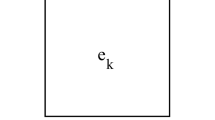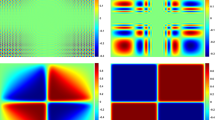Abstract
A fully implicit finite-difference time-domain (FDTD) scheme with second-order space-time accuracy for Maxwell’s equations in a Cole–Cole dispersive medium is proposed and analyzed. The temporal discretization is built upon Crank-Nicolson method, and the Caputo derivative term is based on the recently established \(\mathcal {L}2\text {-}1_{\sigma }\) formula and a weighted approach. A rigorous analysis is carried out to show that the proposed scheme is unconditionally stable and has second-order accuracy in both time and space. 2D and 3D numerical examples are presented to validate our theoretical findings.









Similar content being viewed by others
References
Cole KS, Cole RH (1941) Dispersion and absorption in dielectrics I. Alternating current characteristics. J Chem Phys 9:341–351
Li J, Huang Y (2013) Time-domain finite element methods for Maxwell’s equations in metamaterials. Springer, Berlin
Li J, Huang Y, Lin Y (2011) Developing finite element methods for Maxwell’s equations in a Cole-Cole dispersive medium. SIAM J Sci Comput 33:3153–3174
Fan E, Wang J, Liu Y, Li H, Fang Z (2020) Numerical simulations based on shifted second-order difference/finite element algorithms for the time fractional Maxwell’s system. Eng Comput 1–15
Huang C, Wang L (2019) An accurate spectral method for the transverse magnetic mode of Maxwell equations in Cole-Cole dispersive media. Adv Comput Math 45:707–734
Gibson NL (2015) A polynomial Chaos method for dispersive electromagnetics. Commun Comput Phys 18:1234–1263
Wang J, Zhang J, Zhang Z (2021) A CG-DG method for Maxwell’s equations in Cole-Cole dispersive media. J Comput Appl Math 393:113480
Yee K (1966) Numerical solution of initial boundary value problems involving maxwell’s equations in isotropic media. IEEE Trans Antennas Propag 14:302–307
Tan EL (2008) Fundamental schemes for efficient unconditionally stable implicit finite-difference time-domain methods. IEEE Trans Antennas Propag 56:170–177
Jia H, Li J, Fang Z, Li M (2019) A new FDTD scheme for Maxwell’s equations in Kerr-type nonlinear media. Numer Algorithms 82:223–243
Yang W, Liu L, Huang Y (2019) The FDTD simulation for the performance of dispersive cloak devices. Appl Math Lett 88:171–178
Li J, Shields S (2016) Superconvergence analysis of Yee scheme for metamaterial Maxwell’s equations on non-uniform rectangular meshes. Numerische Mathematik 134:741–781
Wang X, Li J, Fang Z (2018) Development and analysis of Crank-Nicolson scheme for metamaterial Maxwell’s equations on nonuniform rectangular grids. Numer Methods Partial Differ Equ 34:2040–2059
Bai X, Rui H (2021) New energy analysis of Yee scheme for metamaterial Maxwell’s equations on non-uniform rectangular meshes. Adv Appl Math Mech 13:1355–1383
Chen W, Li X, Liang D (2008) Energy-conserved splitting FDTD methods for Maxwell’s equations. Numerische Mathematik 108:445–485
Li W, Liang D (2020) The spatial fourth-order compact splitting FDTD scheme with modified energy-conserved identity for two-dimensional Lorentz model. J Comput Appl Math 367:112428
Gao L, Cao M, Shi R, Guo H (2019) Energy conservation and super convergence analysis of the EC-S-FDTD schemes for Maxwell equations with periodic boundaries. Numer Methods Partial Differ Equ 35:1562–1587
Liang D, Yuan Q (2013) The spatial fourth-order energy-conserved S-FDTD scheme for Maxwell’s equations. J Comput Phys 243:344–364
Kong L, Hong Y, Tian N, Zhou W (2019) Stable and efficient numerical schemes for two-dimensional Maxwell equations in lossy medium. J Comput Phys 397:108703
Huang Y, Chen M, Li J (2020) Development and analysis of both finite element and fourth-order in space finite difference methods for an equivalent Berengers PML model. J Comput Phys 405:109154
Gao L, Zhang B (2013) Optimal error estimates and modified energy conservation identities of the ADI-FDTD scheme on staggered grids for 3D Maxwell’s equations. Sci China Math 56:1705–1726
Huang Y, Chen M, Li J, Lin Y (2018) Numerical analysis of a leapfrog ADI-FDTD method for Maxwell’s equations in lossy media. Comput Math Appl 76:938–956
Zhang Y, Sun Z, Wu H (2011) Error estimates of Crank-Nicolson-type difference schemes for the subdiffusion equation. SIAM J Numer Anal 49:2302–2322
Li Q, Chen Y, Huang Y, Wang Y (2020) Two-grid methods for semilinear time fractional reaction diffusion equations by expanded mixed finite element method. Appl Numer Math 157:38–54
Fu H, Wang H (2019) A preconditioned fast parareal finite difference method for space-time fractional partial differential equation. J Sci Comput 78:1724–1743
Yang Z, Zheng X, Wang H (2020) A variably distributed-order time-fractional diffusion equation: analysis and approximation. Comput Methods Appl Mech Eng 367:113118
Liu Z, Li X, Huang J (2021) Accurate and efficient algorithms with unconditional energy stability for the time fractional Cahn-Hilliard and Allen-Cahn equations. Numer Methods Partial Differ Equ 37:2613–2633
Guo B, Li J, Zmuda H (2006) A new FDTD formulation for wave propagation in biological media with Cole-Cole model. IEEE Microw Wirel Compon Lett 16:633–635
Bia P, Caratelli D, Mescia L, Cicchetti R, Maione G, Prudenzano F (2015) A novel FDTD formulation based on fractional derivatives for dispersive Havriliak-Negami media. Signal Process 107:312–318
Chakarothai J (2018) Novel FDTD scheme for analysis of frequency-dependent medium using fast inverse Laplace transform and Prony’s method. IEEE Trans Antennas Propag 67:6076–6089
Bai X, Rui H (2021) An efficient FDTD algorithm for 2D/3D time fractional Maxwell’s system. Appl Math Lett 116:106992
Bai X, Wang S, Rui H (2021) Numerical analysis of Finite-Difference Time-Domain method for 2D/3D Maxwell’s equations in a Cole-Cole dispersive medium. Comput Math Appl 93:230–252
Alikhanov AA (2015) A new difference scheme for the time fractional diffusion equation. J Comput Phys 280:424–438
Ramezani M, Mokhtari R, Haase G (2020) Some high order formulae for approximating Caputo fractional derivatives. Appl Numer Math 153:300–318
Liu Z, Li X, Zhang X (2020) A fast high-order compact difference method for the fractal mobile/immobile transport equation. Int J Comput Math 97:1860–1883
Yin B, Liu Y, Li H (2020) A class of shifted high-order numerical methods for the fractional mobile/immobile transport equations. Appl Math Comput 368:124799
Yin B, Liu Y, Li H, Zhang Z (2020) Finite element methods based on two families of second-order numerical formulas for the fractional Cable model with smooth solutions. J Sci Comput 84:1–22
Li H, Cao J, Li C (2016) High-order approximation to Caputo derivatives and Caputo-type advection-diffusion equations (III). J Comput Appl Math 299:159–175
Petropoulos PG (2005) On the time-domain response of Cole-Cole dielectrics. IEEE Trans Antennas Propag 53:3741–3746
Yan Y, Sun Z, Zhang J (2017) Fast evaluation of the Caputo fractional derivative and its applications to fractional diffusion equations: a second-order scheme. Commun Comput Phys 22:1028–1048
Lin Y, Xu C (2007) Finite difference/spectral approximations for the time-fractional diffusion equation. J Comput Phys 225:1533–1552
Acknowledgements
The authors would like to thank the editor and reviewers for their constructive comments and suggestions, which helped the authors to improve the quality of the paper significantly. The authors are very grateful to Dr. Jian Huang of Xiangtan University for his assistance in improve the quality of the paper. This work is supported by the National Natural Science Foundation of China Grant No. 12131014.
Author information
Authors and Affiliations
Contributions
XB: Conceptualization, Formal analysis, Methodology, Software, Writing-original draft. HR: Conceptualization, Funding acquisition, Investigation, Methodology, Supervision, Roles/Writing.
Corresponding author
Ethics declarations
Conflict of interest
The authors declare that they have no conflict of interest.
Additional information
Publisher's Note
Springer Nature remains neutral with regard to jurisdictional claims in published maps and institutional affiliations.
Rights and permissions
About this article
Cite this article
Bai, X., Rui, H. A second-order space-time accurate scheme for Maxwell’s equations in a Cole–Cole dispersive medium. Engineering with Computers 38, 5153–5172 (2022). https://doi.org/10.1007/s00366-021-01585-3
Received:
Accepted:
Published:
Issue Date:
DOI: https://doi.org/10.1007/s00366-021-01585-3




